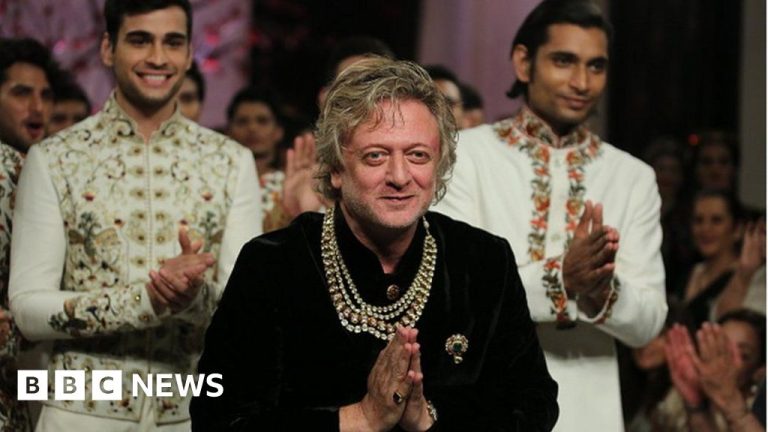Getty Images
Bal's designs were marked by a deep understanding of Indian textiles
Rohit Bal, one of India's most famous fashion designers, has died at the age of 63 after a long illness.
The Fashion Design Council of India (FDCI) announced his death in an Instagram post, saying his work was “redefining Indian fashion.”
One of India's first designers, Bal popularized fashion design as a viable and glamorous profession in the 1990s and many who followed him credit him for their success.
He had been forced to take an extended break due to health issues, but made an emotional return just a few weeks ago.
“We will always need a Rohit Bal to show what classic elegance is – and why it crosses the generation gap,” said an article in The Indian Express newspaper after Bal, looking frail but delighted , appeared alongside her models at the grand finale of Indian Fashion Week in October.
Bal's designs have been acclaimed for his deep understanding of Indian textiles and his meticulous attention to detail.
His innovative designs have been worn by Hollywood stars and models and he has become synonymous with blending India's rich cultural heritage with a contemporary twist.
FDCI/Instagram
Bal (center) made an emotional return to the fashion scene a few weeks ago
Born in Srinagar, Indian-administered Kashmir, in 1961, Bal graduated from St Stephens College, Delhi with an honors degree in history. He then worked for a few years in his family's export business, where he learned the ropes.
After completing his studies in fashion design from the National Institute of Fashion Technology (NIFT) in Delhi, Bal embarked on a journey that would redefine Indian fashion.
He created his own brand and designer line in 1990, then opened several stores in India, the Middle East and Europe.
Getty Images
Model presents Bal creation at fashion show in Delhi
On his website, Bal describes himself as a designer who “combines the right mix of history, folklore, village crafts and dying arts to create imaginative and innovative masterpieces for catwalks and conferences fashion”.
In 1996, Time magazine listed him as India's 'Master of Fabric and Fancy'.
Bal's designs have gone far and wide, with Hollywood actress Uma Thurman and models Cindy Crawford, Naomi Campbell and Pamela Anderson wearing his designs. In 2001, tennis star Anna Kournikova walked the ramp for her Paris fashion show.
Best known for his use of lotus and peacock motifs, Bal used rich fabrics like velvet and brocade. His designs were elaborate, inspired by Indian grandeur and royalty.
Apart from designing clothes for his own brand, Bal has lent his name to promote products ranging from shoes to home linens, tied up with textile giants like the Aditya Birla Group and even ventured into design of luxury jewelry and watches.
He also opened a line for children, saying he believed “children constitute a major consumer class in urban India.”
Bal made costumes for the widely watched Indian game show Kaun Banega Crorepati (Who Wants to Be a Millionaire?) and designed costumes for British Airways cabin crew.
Getty Images
Ball during an encore after a show in Delhi in 1996
It unveiled its first loan line for online retailer Jabong in 2014.
“I want to separate Rohit Bal from Maison Bal – in terms of products as well as style, in terms of price and scope,” Bal told Shefalee Vasudev in Mint.
“Rohit Bal stores (there will be no loan here) will be special. People come to me only for special things – they want clothes that look like handmade works of art. I have in me the power to balance the right and left sides of my body. creative and business tendencies.
When I met Bal years ago in his studio, his signature flamboyance was evident in dazzling neon-colored silks adorned with intricate embroidery; sleek blouses and skirts as well as taffeta skirts and mesh blouses, in bright, warm and cool colors.
“Fabric is the seed of a garment’s design, it’s the lifeblood of fashion,” he told me.
His earliest memories of fabric were totally sensory, he said, recalling the fuzzy feel of a jamawar shawl at home in Srinagar and the soft warmth of his mother's shahtoosh saris.
Getty Images
Bal opened his own restaurant in Delhi
His early years in Srinagar contributed to what he described as a “happy childhood”. The idyllic life, he says, was disrupted by violence in the area, forcing the family to move to Delhi.
Bal remembers embarking on a sartorial journey at the age of 11 when he persuaded his father to visit a tailor shop in Delhi to make his own cowboy pants adorned with pom-poms.
Bal also branched out into the restaurant business and designed the interiors of one of Delhi's posh restaurants, Veda, whose opulent and extravagant interiors created a buzz in the Indian media.
He told me he was also OK if foreign brands like Armani or Hilfiger came to occupy retail space in India.
“They can’t do what I can with Indian designs,” Bal said.
His flamboyant lifestyle prompted Indian media to label him a “fashion bad boy”.
“People see me in photos surrounded by pretty models and think I'm a snobbish, demanding designer who talks about beauty and hedonism. When they meet me, they realize how wrong that perception is,” she said. -he declared to Vasudev.

